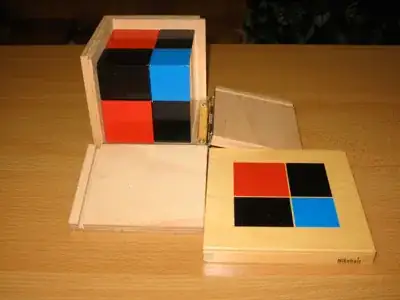One thing you should try is to do a web search for Montessori equipment, much of which is specifically for the purpose of teaching mathematical concepts to 3–6 year olds. The equipment itself is expensive, but it will give you ideas. For example, see here.
One example that comes to mind is that there is a tray designed to hold ten wooden cylinders. Each cylinder has the same height, but a different diameter, and a little knob on top for picking it up; this is the top tray in the picture below. The tray has ten sockets into which the cylinders fit exactly, so that only their tops are visible. You present the three-year-old with the tray with the ten knobs showing, and she will immediately start to take out the cylinders. (The knobs encourage a pincer grip, which is another important skill for three-year-olds.) Then she will examine them, and try to put them back. Some won't go in at all. Some will go in but will be obviously too small for the sockets. A cylinder in the right socket will fit perfectly. She can try moving the cylinders around until she gets them all right; it's obvious to her senses of sight and touch when they aren't right, and then when they are. When she gets all the cylinders back in the sockets, she can take them out and do it again.

When she has mastered the first tray of cylinders, there is a second tray, where each cylinder has the same diameter, but a different height; this is shown at the bottom of the picture. This tray is a little harder, because a short cylinder will fit into a long hole, and the error won't be apparent until later, when the displaced long cylinder has nowhere to go.
Then there is a third tray, where the shortest cylinder has the narrowest diameter and the tallest one has the largest diameter, and a fourth tray where the shortest cylinder has the widest diameter and the longest cylinder has the narrowest diameter.
There are other activities to do with the cylinders. For example, take them out of the tray, mix them up, and then arrange them in order on the table.
Other typical Montessori mathematics equipment:
A basket with ten blue geometric solids: cube, cylinder, cone, sphere, rectangular prism, triangular prism, square pyramid, triangular pyramid, ellipsoid, and ovoid; and correspondingly-shaped cards with figures outlined in blue.
A set of measuring sticks in 10, 20, … 100 cm lengths, with the 10 cm segments painted in alternating red and blue stripes.
A "brown staircase" of $n$×$n$×10 cm brown wooden blocks and a "pink tower" of $n$×$n$×$n$ pink wooden blocks, for $n$ from 1 to 10.
"Binomial" and "trinomial" cubes:

Montessori primary guids explains how these materials are used.

